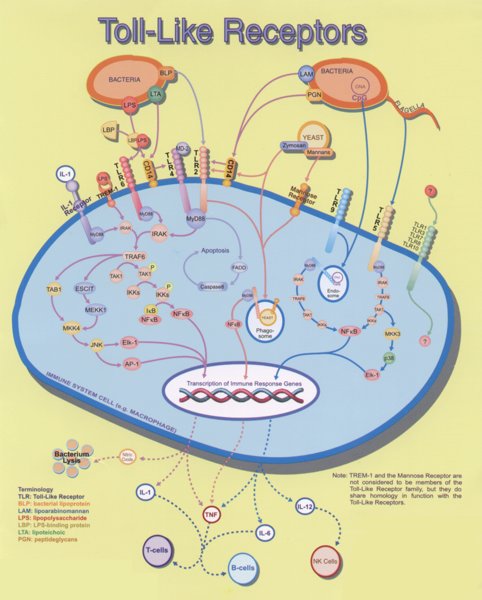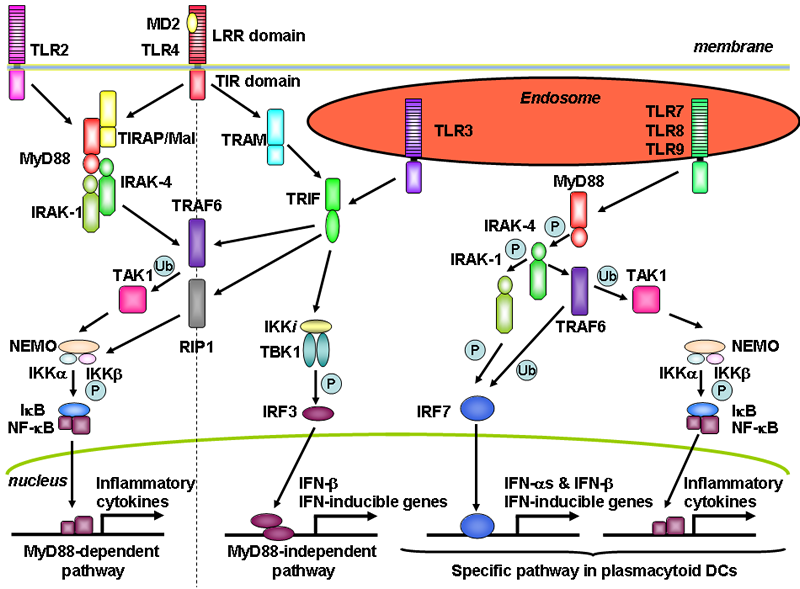Background and Signalling Pathway
From 2006.igem.org
| Line 13: | Line 13: | ||
<h1>Background</h1> | <h1>Background</h1> | ||
[[Image:scheme2.jpg|right|thumb|260px|Figure 1: .]] | [[Image:scheme2.jpg|right|thumb|260px|Figure 1: .]] | ||
| - | <p>When bacteria invade the human body, it has to respond quickly by activation of the innate branch of the immune system, which recognizes the broad spectrum of molecules, | + | <p>When bacteria invade the human body, it has to respond quickly by activation of the innate branch of the immune system, which recognizes the broad spectrum of molecules, specific for pathogenic microorganisms. Immune response cells have on their surface a collection of receptors (Toll-like receptors - TLR), which recognize those "Pathogen associated patterns" or PAMPs. PAMPs include various components of bacteria (e.g. lipopolysaccharides which are part of outer cell membrane of Gram-negative bacteria, flagellin, lipopeptides but also nonmetgylated CpG rich oligonucleotides etc., which are each recognized by one of the 11 TLRs. This kind of cell signalling is the basis of our efficient innate immune response (i.e. the fast-acting, not mediated by antibodies) against microbes. In some instances, however, extensive signalling mediated by TLR is not beneficial. If the cellular response gets out ouf control and becomes exaggerated excessive inflammatory response may lead to sepsis, which can lead to severe organ failure and in about 20% cases cosequences are fatal. Sepsis claims '''each year more than 150,000 casualties''' within the USA and a similar number within the EU. In the absence of an effective treatment of sepsis the analysis of the signaling pathway may indicate the potential therapeutic targets. </p> |
| - | <p>Response to bacterial stimulus is a double-edged sword - too strong response may lead to sepsis, while the too weak response does not contain the bacterial infection, therefor both extremes have to be in the balance.</p> | + | <p>Response to bacterial stimulus is a double-edged sword - too strong response may lead to sepsis, while the too weak response does not contain the bacterial infection, therefor both extremes have to be in the balance. '''The feedback mechanism that would limit the excessive cell stimulation but nevertheless mainatain the responsiveness to bacterial infection may provide a path to an effective antiseptic strategy.'''</p> |
<h1>Signalling pathway of bacterial recognition of the human innate immune system</h1> | <h1>Signalling pathway of bacterial recognition of the human innate immune system</h1> | ||
| - | <p>Toll like receptors (TLRs) are key | + | <p>Toll like receptors (TLRs) are key gatekeepers of innate immunity, sensing and responding to invading microorganisms. So far we know eleven different receptors that recognize specific molecular patterns that are present in microbial components, e.g. lipopeptides, double and single stranded RNA of viruses, CpG containing DNA, glycolipids, and variety of others.</p> |
| - | <p> | + | <p>Most of the molecules involved in the initial stages of cell transduction have been identified, however the complete response is highly complex as for example LPS alone can affect transcription of more than 1000 different genes.</p> |
[[Image:pot4.jpg|thumb|left|300px|Figure 2: .]] | [[Image:pot4.jpg|thumb|left|300px|Figure 2: .]] | ||
| - | <p> | + | <p>Binding of bacterial constituents (PAMPs) to TLR, triggers the association of its intracellular TIR-domains which in the majority of TLRs recruits to the membrane [[Troubleshooting, References & Sponsors#Terms|MyD88]] adapter molecule from the cytoplasm, which in turn that transmit signal to other components of the signaling cascade, as shown on Figure 2. In addition to MyD88 in TLR4 and TLR3 there is an additional MyD88 independent pathway. TLR4 can induce response through both ways, [[Troubleshooting, References & Sponsors#Terms|TLR5]] only through MyD88 dependent pathway.</p> |
<h2>MyD88 dependent pathway</h2> | <h2>MyD88 dependent pathway</h2> | ||
Revision as of 11:10, 23 October 2006

| Home | Proposal & Approach | Anticipated Results & Significance | Troubleshooting, References & Sponsors | Team members |
|---|
Background
When bacteria invade the human body, it has to respond quickly by activation of the innate branch of the immune system, which recognizes the broad spectrum of molecules, specific for pathogenic microorganisms. Immune response cells have on their surface a collection of receptors (Toll-like receptors - TLR), which recognize those "Pathogen associated patterns" or PAMPs. PAMPs include various components of bacteria (e.g. lipopolysaccharides which are part of outer cell membrane of Gram-negative bacteria, flagellin, lipopeptides but also nonmetgylated CpG rich oligonucleotides etc., which are each recognized by one of the 11 TLRs. This kind of cell signalling is the basis of our efficient innate immune response (i.e. the fast-acting, not mediated by antibodies) against microbes. In some instances, however, extensive signalling mediated by TLR is not beneficial. If the cellular response gets out ouf control and becomes exaggerated excessive inflammatory response may lead to sepsis, which can lead to severe organ failure and in about 20% cases cosequences are fatal. Sepsis claims each year more than 150,000 casualties within the USA and a similar number within the EU. In the absence of an effective treatment of sepsis the analysis of the signaling pathway may indicate the potential therapeutic targets.
Response to bacterial stimulus is a double-edged sword - too strong response may lead to sepsis, while the too weak response does not contain the bacterial infection, therefor both extremes have to be in the balance. The feedback mechanism that would limit the excessive cell stimulation but nevertheless mainatain the responsiveness to bacterial infection may provide a path to an effective antiseptic strategy.
Signalling pathway of bacterial recognition of the human innate immune system
Toll like receptors (TLRs) are key gatekeepers of innate immunity, sensing and responding to invading microorganisms. So far we know eleven different receptors that recognize specific molecular patterns that are present in microbial components, e.g. lipopeptides, double and single stranded RNA of viruses, CpG containing DNA, glycolipids, and variety of others.
Most of the molecules involved in the initial stages of cell transduction have been identified, however the complete response is highly complex as for example LPS alone can affect transcription of more than 1000 different genes.
Binding of bacterial constituents (PAMPs) to TLR, triggers the association of its intracellular TIR-domains which in the majority of TLRs recruits to the membrane MyD88 adapter molecule from the cytoplasm, which in turn that transmit signal to other components of the signaling cascade, as shown on Figure 2. In addition to MyD88 in TLR4 and TLR3 there is an additional MyD88 independent pathway. TLR4 can induce response through both ways, TLR5 only through MyD88 dependent pathway.
MyD88 dependent pathway
When receptors sense the presence of microbial components, stimulation of TLRs occurs and triggers the association of MyD88 (myeloid differentiation primary-response protein 88), which in turn recruits IRAK4, thereby allowing association with IRAK1. IRAK4 phosphorylates IRAK1 and with phosphorylated IRAK1, TRAF6 (tumour-necrosis-factor receptor- associated factor 6) associates. The complex of phosphorylated IRAK1 and TRAF6 dissociats from the receptor and form a complex with TAK1, TAB1 and TAB2, which induces the phosphorylation of TAB2 and TAK1. This leads to the ubiquitylation of TRAF6, which induces the activation of TAK1. TAK1 phosphorylates IKK complex (inhibitor of nuclear factor κB (IκB)-kinase complex), which consists of IKKα, IKKβ and IKKγ. The IKK complex then phosphorylates IκB, which leads to its ubiquitylation and subsequent degradation. This allows NFκB to translocate to the nucleus and to induce the expression of its target genes, such as cytokines and chemokines.
Inflammatory cytokines, chemokines and interferons attract cells of immune system (lymphocytes, macrophages) to infected area. This seems to be beneficial to organism, but it can also lead to severe inflammation and sepsis.
Some receptors mediate response through MyD88-independent pathway. A number of genes known to be interferon(IFN)-inducible genes was identified.
komentarji:
- označi za vsako sliko, kaj pomeni in od kod je
- {Marko, 21.10.} V petek na sluzbenem racunalniku so bili naslovi poglavij se vedno stlaceni v 1 vrsti, na prenosniku pa so v redu - preverite, ali je to odvisno od locljivosti ekrana oz. ali je pri vseh (ostalih) razpored poglavij v 2 vrsticah v redu.
- (Rok, 21.10/20h) To se je na mojem računalniku tudi pojavilo, vendar samo na nekaterih straneh. Problem je v tem, da če so naslovi poglavij prekratki, jih stlači v eno vrstico. Včeraj zvečer pa sem oblikoval tako, da je povsod enako
| Home | Proposal & Approach | Anticipated Results & Significance | Troubleshooting, References & Sponsors | Team members |
|---|


